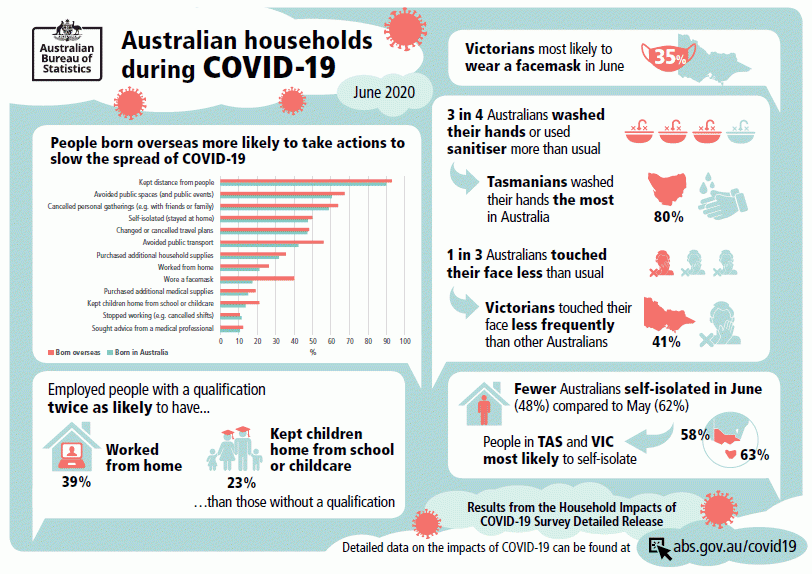About this issue
The Household Impacts of COVID-19 Survey, Detailed Release provides insight into personal experiences during the spread of COVID-19 in Australia, and was collected between 7 and 20 June 2020.
The Household Impacts of COVID-19 Survey, Detailed Release presents information on:
- Level of concern for personal health due to COVID-19
- Actions taken in the last four weeks in response to COVID-19
- Receipt and use of Government stimulus payments
- Flu vaccinations
The scope of this survey was people aged 18 years and over in private dwellings across Australia.
About this collection
The findings below were collected as part of the Multi-Purpose Household Survey (MPHS) from approximately 2,500 people via telephone interview. The MPHS, undertaken each financial year by the Australian Bureau of Statistics (ABS), is a supplement to the monthly Labour Force Survey (LFS) and is designed to collect statistics for a number of small, self-contained topics. For further information about the collection of this data, please refer to the Methodology.
This survey was designed to provide data on how Australians were responding to the spread of COVID-19. At the time of the June survey, initiatives in place to help reduce the spread of COVID-19 and support the economy included:
- International travel restrictions
- An economic stimulus package (announced 12 March)
- Border control measures for some states and territories
- Shutting down of non-essential services and a second economic stimulus package (22 March)
- A safety net package of $1.1 billion to expand mental health and tele-health services, increase domestic violence services and provide more emergency food relief (29 March)
- Social distancing rules and additional shutdown restrictions (20–30 March)
- Free childcare for working parents (2 April)
- A JobKeeper payment passed in legislation on 15 April, to keep more Australians in jobs and support businesses affected by the COVID-19 restrictions
- Easing of restrictions on elective surgery gradually from 28 April
- Announcing a Federal Government three-stage plan on 8 May to begin easing restrictions
Survey collection timeline
Image

Description
Proportions marked with an asterisk (*) have a Margin of Error (MoE) greater than 10 percentage points which should be considered when using this information. For more information about MoE refer to the publication Methodology.
